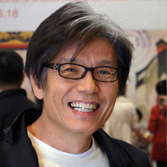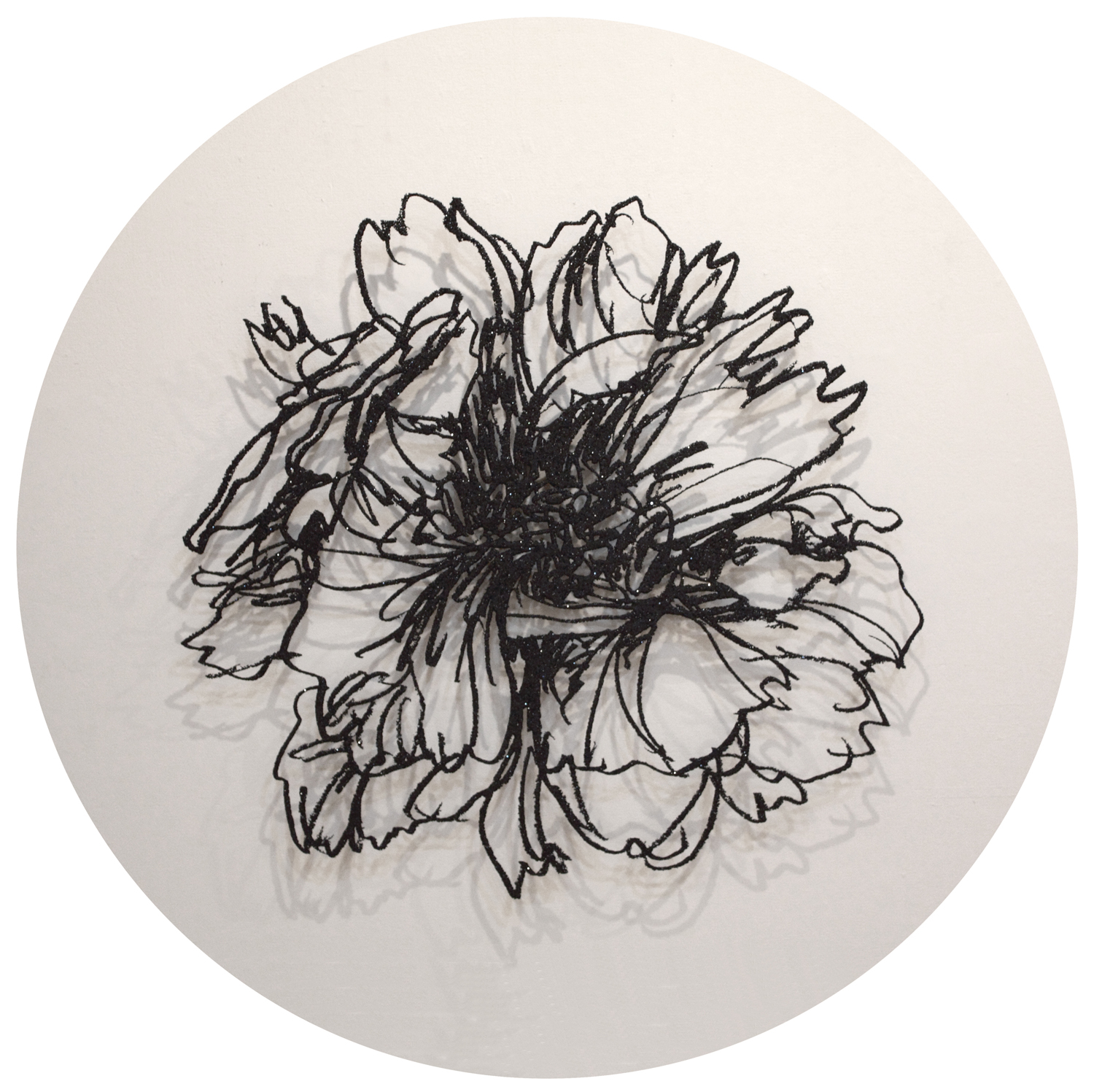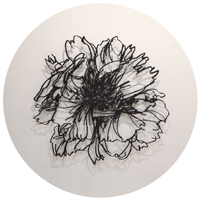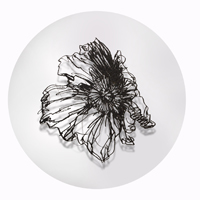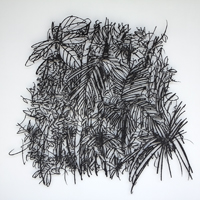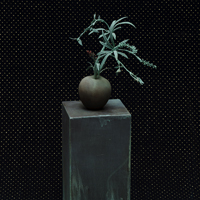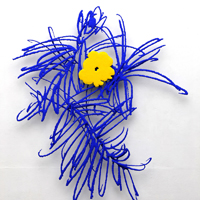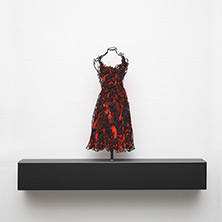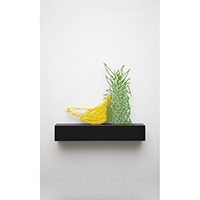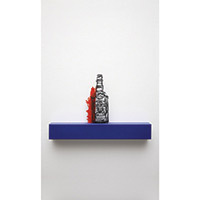Image & Memory
1. Prolog
Nowadays we live through infinite time and space, and various images in the virtual space of a computer beyond ‘the world of things.’ A new technology developing day by day creates a virtual reality, and blurs the lines between virtual and real world. Our desire and pleasure has escaped from a system of industrial capitalism focused on the exchange value of a currency, or fetishism. We are now satisfied with and enjoy not an object itself but the social codes and symbols of an object image. Such a cultural outlook by Jean Baudrillard as “the era of simulation that sign and image control our life” has been realized. This era of simulation is just like both a divide and a breakthrough for the modern generation under the system of industrial capitalism. Especially this aspect of conversion sounds like a cataclysm of identity for the artists of medium standing with their own visual vocabulary, and alienates and pushes their art world into the past rapidly. It brings about a lack of understanding between generations just as the boundaries of countries based on a modern arrangement, and ultimately isolates the world of art today.
In this respect, it needs to pay attention to Kim Jonak’s painting of simulacres based on a combination of 'Image-Sign'. His work has consistently brought forth 'a vigorous energy of organisms', corresponding to the change of paradigms with the times. Kim Jonak has daringly adopted and used a new form, medium, materials, and technology in response to the cultural discourse and art trend with the times, and produced a new version of his works. In virtue of such efforts, he keeps pace with the times and still accomplishes not only a preservation of identity but also a ceaseless self-innovation. He considers a work of paintings as a process of introspection, and also is on his guard against adhering to the past fashion. His achievement, resulted from his strict will and outlook on the art world, is significant in that it is a touchstone especially for the young artists of hyperrealism paintings in the 2000s.
2. 'Virtual Image - Life Force' penetrating the aesthetics of the future
Kim Jonak’s debut work absolutely demonstrates his unique insight into the times and imagination of paintings. His debut work, 'Virtual Image-Life Force', shows a death cry of people behind a white cloth in the form of hyperrealism. This work took a special prize in Joongang Fine Arts Prize, and Donga Fine Arts Prize in Donga Art Competition in 1982 after graduating from college. As well-known, these two competitions were the gateway to success in the art world for a number of young artists, which Korean major newspaper companies established as an alternative to overcome a contradiction of the world of art between an old academism like the National Art Exhibition under Japanese imperialism and an elite abstract painting seeking for an avant-garde experiment.
The reason that I particularly pay attention to the prizewinning work is not because of an interest in the popularity and fame of his work. His prizewinning work was made in the form of representation based on hyperrealism prevalent in the college of fine arts of those days. However, in contrast to the other hyperrealist paintings, his work presented a desperate escape from unnatural conditions as if like a drama, and suggested structurally both a flatness as an essential matter of paintings and an expression of space. His painting was not a representation of reality but a creation and organization of a certain event. He projected a duality of canvas which included a surface of canvas for a viewer and the other side of it as well. He took notice of a dual space of canvas, and so created some state of the back of canvas. The picture on the canvas effectively emphasized some parts of the body, especially a grip pulling a curtain and the rumples of it. Actually history of paintings had dived into creating only an illusion of a three-dimensional representation in the canvas, or a flatness of a two-dimensional canvas as an essential purity of paintings. Since then, it was Lucio Fontana who presented a duality of canvas space in the form of cut-off paintings by piercing his canvas. Kim Jonak, however, didn’t adhere to Lucio Fontana’s spatial conceptions in relation to the canvas as an object. Kim Jonak pierced a canvas surface as if to give an escape to people behind the canvas. Furthermore, his ruptures and tears of the canvas surface was not pierced but represented completely. Therefore the effect of an illusion became maximized. In this sense, his picture with an illusion of space through trompe l'oeil depiction is a presented world without reality and hyperrealist image in itself. This is reality without the original as the world of simulacres.
Jean Baudrillard’s book on socio-cultural phenomena was published in French at first time in 1981, which foresaw the actualization of “the world of simulation free from the original and reality.” And Kim Jonak’s series of simulacres, 'Virtual Image-Life Force', was awarded the next year. It is a wonder that a painter and a philosopher, such as, Kim Jonak and Jean Baudrillard who were a long distance away from each other like a country on the other side of the world, sympathized with each other and corresponded to the changes of contemporary visual aspects. It is even more surprised in that Jean Baudrillard’s theory had not introduced into Korea by that time and there was a gap of socio-cultural conditions between Korea and France. As a result, we can find a transition from modern to postmodern aesthetics in Kim Jonak’s paintings, and also can’t but pay attention to his work henceforth.
3. The verbification of 'Image-Sign': a leap to life
Kim Jonak got away from daily routine in 1989 when he was acknowledged with his own world of art. An extreme opposition, between monochrome paintings based on the aesthetics of modernism and realism paintings focused on criticizing society, came to a state of lull at that time. And the phases of postmodern culture from America were complicatedly involved. He had devoted himself to study materials and techniques of art abroad in France until 1994. As his retrospect as follows, “I had insensitively kept on painting and erasing for three years,” he attempted to reduce and take off a way of thinking and perception acquired in Korean society based on high growth and groupism, or collectivism. In the end, what he found in Paris, a center of modernism painting, was a grand energy of life inherent in a bunch of grapes which his wife put on a table. The discovery of life led him to take an interest in the subject, and then he found a self and world constituted with complex and multiple elements, for example, “East and West, the modern and the traditional, figuration and abstraction, the maximum and the minimum.”
His escape from a conventional vision and thought also led him to be interested in some ad-posters on a wall or board in Paris. A discovery of this motif was actually due to his artistic intuition, or an instinct as an artist. And such an experience in Paris played an influential role in actualizing the image world of simulacres afterwards. The properties of ad-posters renewed ceaselessly were accumulated with different information and innumerable sight of people on the street. Kim Jonak combined some images and words of posters, or the accumulated time and traces of people with an image of organisms, and then revived them as an expressionist painting. It means a kind of the present communication between some private memories and public remembrances. He represented a billboard just like a surface of corten steel as in the case of minimal art, so reused it as a background support for a picture. His adoption of motif and techniques in a process of this work seems to reach the level of an artisan in the Middle Ages. He meets enough the conditions necessary for an artist that Henri Focillon indicated before, which are important in relation to both an insight into the essential and a technique of expression.
A huge magnified cuttlefish and a bunch of grapes appear like a fossil in the middle of a supporting plane. That image, with rich materials and energetic brush strokes by numerous repetitions, is a materialization of the energy of organisms which suddenly dawned upon Kim Jonak one day. There are some words and a numeral of black letter in his painting. Specifically the words, such as ‘the other’ and ‘a desire,’ were adopted from the latest cultural discourse. The sign of words and a numeral in his work is a media as a discourse which delivers a message of his conscious and unconscious desire or of society, and reveals the reality of our art. The magnified images of still life do not refer to a simple organism, but bring about some energy of an organism which Kim Jonak sympathized with. Lastly he fastened with a real bolt to fix a paper of picture to the billboard of ad-posters, and his work gave an indication of a real object. This combination of image and sign with a real bolt collapsed a boundary between reality and illusion, so simulacres came to be realized at this point. The conversion of Simulacres into a solid structure, divided into a unit of thirty centimeters, showed literalism of objects similar to minimal art, and at the same time an expressionist painting on rusty steel.
4. Conclusion: Prospect
Kim Jonak tried to change his work again, based on the ripened history as an artist of medium standing. His studio became a car factory and sometimes a digital print shop. Here a new work was created for this exhibition, which was made of a free drawing with scarlet industrial paint on some translucent materials, that is, astel plate glass. This car paint is as light and bright as astel plate glass in relation to a color effect and matiere. Therefore, we can see Kim Jonak’s will to reflect a contemporary sensibility seeking for the lightness of being. This latest work shows a combination of still life image and sign between words and a numeral similar to his works before. So the images imply consistently the function of words and a numeral as a media, or a memory of some energy of organisms and a flow of consciousness as well. However, these images emphasize a materiality of astel plate glass and car paints by his immediate touch, quite contrary to a coarse paper plane. In result, superficial painting comes to appear in the era of infinite creation of images.
Kim Jonak suggests his new series as “an image of something sticking out his palm of reason beyond all bearing.” His new work implies the resistance of the unknown, new materials and a contemporary sensibility, and ultimately reflects the smooth relations of people mediated by media in the information age, and at the same time a leap to life.
In this way, Kim Jonak’s painting allows us to see it tactually and feel as if both a deep, low-pitched and a light, high-pitched tone like hip-hop music. According to his mention, “his work takes care of everything around him, but doesn’t characterize anything. It includes East and West, figuration and abstraction, and artistic discourses at home and abroad, but doesn’t depend on a specific ism or trend.” In short, he entirely denies the established genealogy. Of course, his work, 'Image-Sign' as the world of simulacres, is never completely free from the socio-cultural memories of the time immanent in Korean modern history, art history including a trend of contemporary art, and new materials and techniques over his own life as an artist from 1980 to 2009. However, as his various simulacres and techniques are enough efficient to bring about something delicate between ‘difference’ and ‘differment,’ it is certain that his work is going to demonstrate ‘an autonomous self-preservation of art for itself.’
Kim Young Soon (Art Critic)
I like the irony of Kim Jonak's works, but also their sense of emotional conviction and urgency: Kim problematizes painting in the very act of making seriously expressionist paintings. He calls painting into question even as he makes paintings that distill traditional and modernist ideas of painting.
Thus, his subject matter is traditional-the proverbial fruit of life. from grapes to the biblical apple of desire - but he renders it in a fragmented. conceptual way. involving the use of language, calligraphic gesture, and the grid. His materials epitomize this dialectic: he will paint on traditional paper(as in From Life, 1996), but in a very modern way. bolt the paper to a wooden ground (the wood is also traditional material). This interplay is not purely intellectual, that is, not simply a postmodern game of painting the hunting result is a stunning. seductive image, at once dramatic and melancholy.
The fruit is full of overripe, forbidden passion - decadent and tantalizing(fatal black and delicious red), indeed, all the more tantalizing because it is decadent. that is because it has been consumed again and again, with no lasting satisfaction. there is a complusive vehemence to kim's paintings: a desperate sense of unrequited desire in the midst of satiation. It is the perversity of this that I admire, for it is emotionally precise.
Kim, then, is a symbolist, even as he is postmodernist. He reconciles Eastern and Western ideas of art making, without losing the sense of their difference. In fact, I think his Eastern sense that art exists to mediate and stimulate a certain experience. at once contemplative and vita - esthetic and rejuvenating - breathes new purpose into Western methods that have become standardized, not to say clich'ed. Kim's "religious" respect for certain facts of emotional life gives the modern Western ideology of from for from's sake a new lease on life.
Donald Kuspit (Art Critic)
Paradox in Duality: Kim Jonak’s art world
One can rarely come across an artist who affirms the idea that verbal language is inferior to visual language. Words, unilateral and superficial some times, reveals its limit when they are articulated for an image, which represents contradictory facets all at once. It is due to this reason that one cannot find quite right words to express what one sees in Kim Jonak’s painting. There is a feeling of missing about as such with which one cannot apprehend his work of which condensed visual language evades verbal one. For this pictorial structure, I would like to call ‘paradoxial duality’ and such optics is, I think, closely related to his ‘Koreanness’ or ‘Korean identity’ so called.
Kim’s large canvases, well known for their black choreography of mostly single object such as grapes, are bold, impassionate and intense. Recently, such heavy gravity is enlightened and contrasted with softly grounded stone powder applied on the surface. A reason for that his work is often well matched with a modern surrounding of gallery space is not because of its monumental size but because of his way of representing an image, which consists of mass cultural fragments out of contemporaneous experiences.
Over the patches of commercial posters attached onto a canvas, Kim executes expressive brushstrokes on it. Mass cultural images are literally buried by his rigorous and expressive gesture of paint. The latter, much stronger to draw attention of the viewer, reminding of Pop Art or commercialised art, is hard to be noticed. Coexistence of the two different facets, contradictory as it looks, refers to paradoxical duality of his work. His expressionism is never delivered in a direct and outpouring way. Rather, it is exposed with a sense of great restraint or reservation put on by the artist himself. This is, what I feel as his Koreanness, if it is not meant to be over-generalised.
Kim’s gestural brushstrokes, energetic and painterly, overwhelms the viewer’s eyes as if steel has been pressed upon the canvas with enormous power. Pictorial force in Kim’s work comes out of such process of compression, transforming three dimensional piece into two dimensional surface. What needs to be highlighted in his work is materiality or physicality of paint itself. Condensed layer of painted surface holds striking energy under its steel-like skin. One can say that Kim fixes tension and anxiety onto the firm surface of his painting. ‘Fixing’ or ‘holding’ might be a right word for what Kim’s work is attempting to do, which is confirmed by those bolt nails found in his canvases. The painted surface of his strong brushwork suppresses what is underneath of it: one can call it desire. The question of ‘desire for what?’ is opened in his art. The only thing we see is the captured intensity of such anonymous desire. This is why I define his work is fundamentally abstract. No matter what he paints, Kim’s painting emanates this vital, indescribable energy rooted in living things. Almost physical as it seems, ‘blood vessels’ of black choreography of Kim’s painting both contains and reveals its expressive force. There is a sense of restraint and containment, something that is only identifiable in Oriental(Korean) painting.
Paradox in duality finds an appropriate expression in the artist's own words: ‘There are contradictory elements mixed up in my being and I hope that it could only be revealed in my painting’.
Young Paik Chun(Professor of Hongik University, Ph.D in Art History)






